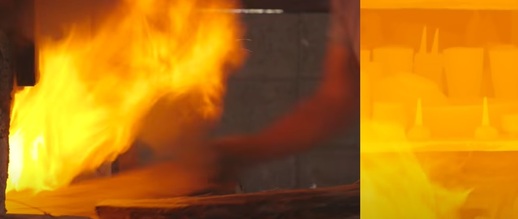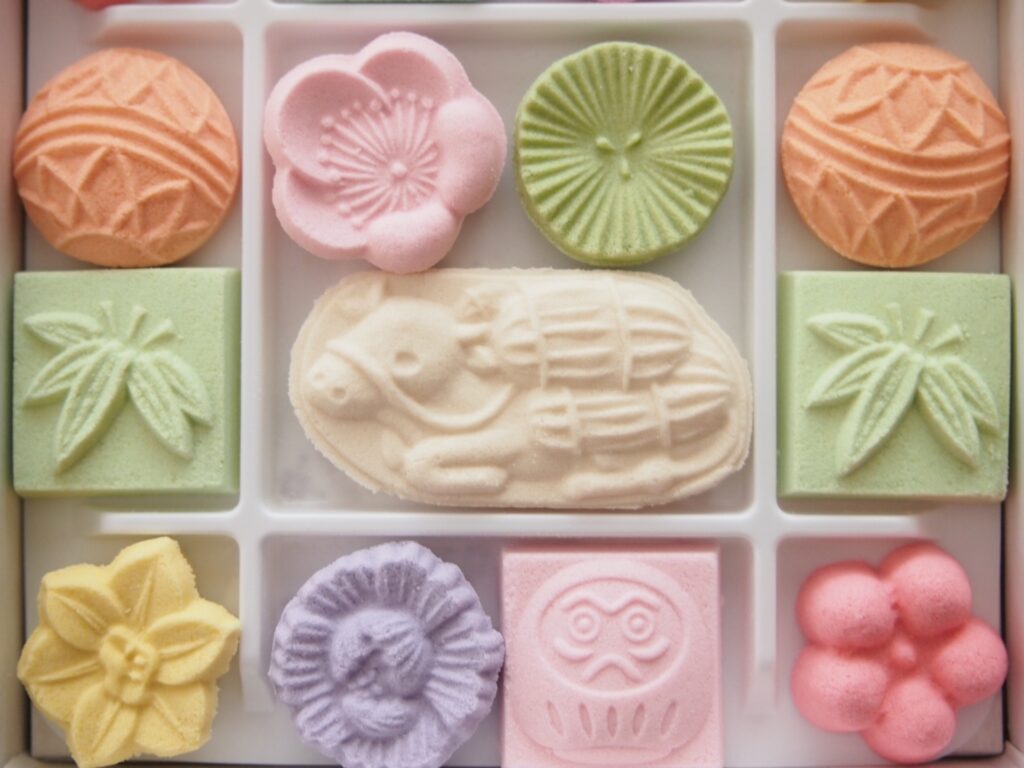2024.09.05
伝検通信(メルマガ)週刊メールマガジン「伝検通信」 第22号
週刊メールマガジン「伝検通信」第22号をお届けします。
今号のトップ記事は、宙ちゃんの「伝統文化一直線」 第11回 偶然が生み出す美についてです。
「クイズで肩慣らし」は前回クイズの答え・解説と、茶道・和菓子・日本茶分野からの出題です。
メルマガ登録した方の中から抽選で100人に公式テキストをプレゼントするキャンペーンは、8月31日で締め切りました。厳正な抽選を実施し、当選者にお届けします。
伝検公式サイトでは、2級と3級の模擬試験(練習問題)を掲載しています。
ぜひ腕試しとしてご覧ください。
2級模擬試験
https://denken-test.jp/
3級模擬試験
https://denken-test.jp/
目次
・ 宙ちゃんの「伝統文化一直線」 第11回 偶然の美
・ 「クイズで肩慣らし」第22回(茶道・和菓子・日本茶)=「和三盆」
・ 伝検協会だより
宙ちゃんの「伝統文化一直線」 第11回 偶然の美
近藤宙時=日本伝統文化検定協会理事

備前焼の焼成作業。「窯変(ようへん)」
(一般財団法人 伝統的工芸品産業振興協会「伝統工芸 青山スクエア」の映像「手技TEWAZA『備前焼』」から)
まずは、こちらのリンクから、五島美術館(東京都世田谷区)が所蔵する、ある有名な陶器(重要文化財)の写真をご覧ください。
───────────────────────────────────────
「破袋(やぶれぶくろ)」と名付けられた伊賀焼の水差しです。名前の通りに下部が大きく割れています。しかも、大きな力で下に向けて押しつぶしたように、全体に大きくゆがんでいます。恐らく小石と思われるブツブツもあちこちに見えます。緑色の自然釉(ゆう)も一様ではなく、濃淡があります。どうひいき目に見ても失敗作です。とても売り物になるような代物ではありません。即「廃棄処分!」と決めてかかるのが普通の感覚ではないでしょうか。
ところが、これは、豊臣秀吉、徳川家康と2代にわたって茶頭(さどう)を務めた戦国時代随一の大名茶人古田織部(ふるた・おりべ)が「今後是程(これほど)のもなく候」と最大級の賛辞を贈った名品中の名品なのです。こんな歪(いびつ)な物を「不世出の名品」とたたえる感覚が日本の伝統文化には脈々と流れています。皮膚感覚にまで昇華した、物を見る時のこうした態度と言うか、鑑賞法にこそ、日本の伝統文化の唯一無二性があるとさえ思っています。
「作為がある」、あるいは「作意が見える」という言葉があります。「作者の意図が見え見えだ」と感じる時に使う言葉で、良い意味で使われることはまずありません。それが当然のことだと日本人は思っています。しかし、考えてみると不思議なことです。
芸術家であれ、職人であれ、人が何かを作る時には当然「こういう物を作りたい」という意図や思いがあるはずです。それなくして人が物を作ることはありません。物を作る時の作者の思いが、その作り出した物に如実に表れてこその「作品」でしょう。作品なのだから、「作為がある」のは当たり前のはずなのです。恐らく西洋的なものの見方では、「作意が見えない」物はダメな作品であり、「作意が見える」、「作意が如実に表れている」作品こそが評価されるべきものということになるのではないでしょうか(宙ちゃんは西洋人ではないので、あくまで勝手な推測ですが)。
「作為がある」の反対語は、当然のことながら「作為がない」です。そして、「作為がない」とは「自然に任せた」ということになります。この「作為がない」ことを尊ぶ感覚の底には、「人の作為は自然には及ばない」という考え方があるように思います。自然が作り出す形や色に対する繊細な美意識と言い換えてもいいでしょう。花を美しいと思うのはもちろんのこと、風に揺れる木々から、崩れる高波、横殴りの雨にまで日本人は美を見いだしてきました。
冒頭で紹介した「破袋」は、たまたま自然の重力でへしゃげてしまった水差しをそのまま焼成したものです。しかも焼成温度が高過ぎて亀裂が入ってしまった。そのへしゃげ方、亀裂の入り方が絶妙で、素晴らしく絵になる。こんな偶然は二度とないだろうという意味で、古田織部は「今後是程のもなく候」と激賞したのだと推察します。
織部は、有名なへしゃげた茶碗「沓形(くつがた)茶碗」を生み出しました。もちろん、そこにわざとらしさがあってはいけません。「作意が見え」ては台無しになるのです。作者は「こういう物を生み出したい」と意図を持って作るのですが、最後の部分は自然に任せる。それが、日本の伝統文化の物作りの姿勢であり、鑑賞する時の視座なのだと思います。
「破袋」が最高傑作と評価されたのは、20世紀の抽象表現主義を代表するアメリカ人画家、ジャクソン・ポロックが生まれるはるか昔のことでした。水墨画の「たらしこみ技法」、備前焼の「ひだすき」や「ぼたもち」、修理法としての「金継ぎ」、さらには庭の借景など、人の技と自然が一体となった美の伝統は、まさに日本独自のものだと言えるでしょう。
「クイズで肩慣らし」第22回(茶道・和菓子・日本茶)=「和三盆」
~伝検公式テキスト(9月20日先行発売予定)のジャンルごとに出題します~

美しい色や形の干菓子「和三盆」
第22回
問題:目にも美しい色や形の干菓子(ひがし)「和三盆」。香川県と徳島県で生産される高級砂糖「和三盆糖」のみで作られていますが、その和三盆糖は何という品種のサトウキビから作られるでしょう。
(答えと解説は次号で)

青い空と日暮れの赤が混じり、薄紫に染まる空
【前回の問題と答え・解説】
問題:中国から伝わった日本の暦の一つ、二十四節気( にじゅうしせっき)で処暑の終わりに当たる9月初めの夕暮れ時、 青い空と日暮れの赤が混じり薄紫に染まります。 昔から空にもさまざまな色名が付けられています。この空の色は『 ○○空色』と呼ばれていますが、○○に入る言葉は何でしょう。
答え:紅掛(べにかけ)
解説:うっすらと赤みを帯びた淡い空色が「紅掛空色」です。夕暮れ時に、青い空と夕日の赤が混ざり合った色で、藍で下染めした空色の上から紅花を重ねて染める染色法から名付けられました。このほかにも、夜が明け太陽で白み始める空を「曙色(あけぼのいろ)」、晴天の澄んだ空を「天色(あまいろ)」、夕方のほの暗い空を「瞑色(めいしょく)」と呼ぶ表現もあり、季節や時間の移ろいを踏まえ、美しい日本語で空の色を表しています。
伝検協会だより
▼弊会の新たな会員として、うかい(正会員)と京都産業振興センター(一般会員)の2社、さらに個人3名(一般会員)に加わっていただきました。
国内外に和洋食レストランを展開する「うかい」は食文化の発信に加え、箱根ガラスの森美術館も運営。京都産業振興センターは京都市勧業館「みやこめっせ」や京都伝統産業ミュージアムを運営するなどしています。弊会としても会員との連携を深め、伝統文化・産業の継承、発展に貢献していきます。
▼香川県の工芸品「香川漆器」と「菓子木型」の工房を見学してきました。香川漆器の工房「さぬきうるし Sinra(しんら)」の漆芸家、松本光太さんは、より多くの人に興味を持ってもらおうと新しい取り組みに挑戦されている姿が印象的でした。松本さんの作品は羽田空港内のセレクトショップでも販売されており、訪日客の人気も高いそうです。一方、和菓子づくりに欠かせない菓子木型ですが、現在、職人は全国でわずか数人しかいないそうです。四国で唯一の職人である市原吉博さんは「木型には一切妥協しない」と厳しい表情を浮かべつつ、「工房を訪れた人の笑顔を見るのが一番うれしい」と優しい笑顔も見せていました。
編集後記
伝検通信第22号をお届けしました。「暑い」「暑い」と言っていたら、あっという間に台風と豪雨に翻弄される日々になってしまいました。先人の知恵と美意識にならい、自然と共に生きる知恵を創出していかなくてはと思わされる日々です。
カテゴリー: 伝検通信(メルマガ)





